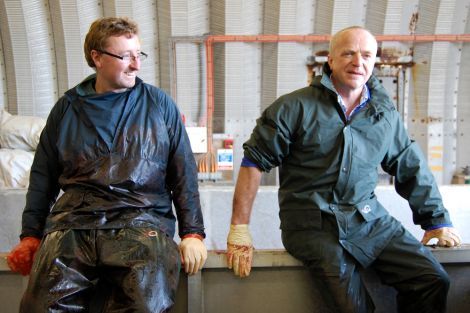News / Mystery surrounds death of whale
SPECIALIST vets who carried out a post mortem on the long-finned pilot whale that died in Shetland’s oil port of Sullom Voe at the weekend said the cause of death remains unclear.
Bob Reid and Andrew Brownlow, from the Inverness-based SAC Wildlife Unit, spent three hours on Tuesday morning working on the adult female whale, which stranded on Saturday night.
The whale had arrived in the voe on Thursday with two other pilot whales, both of which disappeared that day.
During its three day ordeal it beached at least four times and swam in ever decreasing circles around the port, which is very busy at the moment with the construction of the £500 million Total gas plant.
The vets said that it was a very small, fully grown female measuring 4.51 metres – the normal size of an adult female is 4.9 to 5.5m. It had probably had two or three calves during its lifetime, they said.
Mr Brownlow said that on first inspection there was no obvious explanation why it had stranded.
The vets took samples from all of the creature’s major organs as well as its brain, which will be tested in laboratory conditions in Inverness and Edinburgh at the Moredun Research Centre.
“There is nothing obvious that we found from the post mortem that we can say with any degree of certainty that this is what is the cause of death, but I am pretty confident that by the time we have finished these tests we will have a fair idea of why it stranded,” he said.
“What we can rule out is that there are no major areas of trauma and it doesn’t seem to have any infection or bruising. It has moderate body condition, but it’s not emaciated and as yet there is no evidence of anything at all that would have debilitated it.”
Become a member of Shetland News
One question is why it was in the busy port in the first place. When asked if it could have been disoriented by noise from the construction work in the area, Mr Brownlow said the simple answer was “unproven”.
Mr Reid, who has more than 20 years experience in the field, said that he believed the creature had been unwell.
“My feeling is that (the other two whales) were following in a sick animal, but I don’t know. We have no evidence to back that up at all,” he said.
He pointed out that whales have been stranding for centuries and that it is a natural process. Every year he deals with around 160 stranded cetaceans around Scotland, and carried out 109 post mortems on marine mammals last year, including three or four pilot whales.
Pilot whales, also known as caain’ whales in Shetland, have a history of mass strandings. In the 1980s hundreds stranded around the islands, which some people put down to the amount of seismic work going on as the oil industry explored the North Sea.
With exploration activity increasing again as the industry moves into waters north and west of Shetland, concerns have been raised that similar problems could arise.
However Karen Hall, of the Lerwick SNH office, explained that the environmental conditions imposed on the oil industry these days are “quite stringent” and involve a great deal of monitoring.
Total have employed a team of ecologists to keep a close eye on environmental activity around the Sullom Voe area and have altered their plans to accommodate local wildlife.
The vets thanked Ellis Nicolson, of EMN Plant, and the staff at Shetland Islands Council’s ports and harbours department for their help in carrying out the post mortem.
Become a member of Shetland News
Shetland News is asking its readers to consider paying for membership to get additional perks:
- Removal of third-party ads;
- Bookmark posts to read later;
- Exclusive curated weekly newsletter;
- Hide membership messages;
- Comments open for discussion.
If you appreciate what we do and feel strongly about impartial local journalism, then please become a member of Shetland News by either making a single payment, or setting up a monthly, quarterly or yearly subscription.




























































